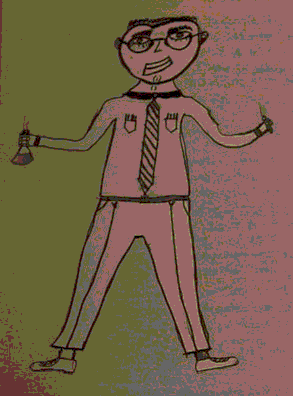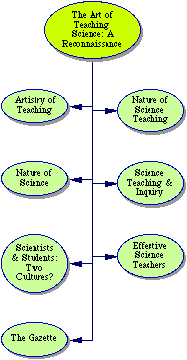

Whether you are teaching a full semester course, a workshop for teachers extending over a term, or a summer institute, your syllabus will be turned into individual lesson plans. Not knowing the length of your teaching sessions, I've described several "agenda building activities" that you can pick and choose from to build your lessons. These can be construed as classroom or online activities, or problem solving projects. Each is based on The Art of Teaching Science.
Note: I've developed a Powerpoint Presentation for this chapter (and all of the others) that you can access at the Oxford University website for The Art of Teaching Science. Together with these agenda strategies and projects, you will have powerful resources to create a science education course or workshop based on The Art of Teaching Science.
|
SECTION 1: A RECONNAISSANCE EEEP #1---The Penny and a Glass of water. I like to start class sessions, especially at the beginning of a course, with an EEEP (Exciting Example of Everyday Experience). EEEP's are similar to demonstrations or discrepent events that you may be already be using. After students have arrived, and settled in, conduct the following EEEP. Present a full glass of water to the students. Ask them to predict how many pennies can be carefully dropped into the full glass of water. Note the students' predictions. If you want to take some extra time, have teams of students work together to talk through their predictions. In front of the entire class, drop one penny at a time into the glass of water. (Note: If you hold the penny so it slides into the water vertically, as opposed to on one of its sides, then you ought to be able to drop between 20 - 50 pennies in a full glass of water.) Invite the students to work in small teams to illustrate and describe in words their explanation of this EEEP. You see the results of three different high school chemistry students on this EEEP. Note the drawing and the related very descriptions and labeling. The teacher used an EEEP activity sheet that individual or small groups of students used to process their thinking during an EEEP. This is a powerful way to extend the value of a demonstration so that it becomes beoth a cooperative learning activity, and a constructivist-oriented activity as well. Kids Are Just Like Scientists--Initial Case Study The case studies in The Art of Teaching Science are problem solving dilemmas based on actual and fictional events about science teaching. I've written one case study to introduce each chapter, and you will find addtional cases in the Science Teacher Gazette section of each chapter. Have your students read the case (p. 3). In teams of two or three have students discuss what they would do if they were in the situation, and be prepared to share a consensus opinion with the class. This, and other cases in the book can also be used for online discussions using a bulletiin board. If you do not have access to a bulletin board, go to Nicenet to set one up as part of a course. Inquiry 1.1. Exploring Your Initial Ideas About Science Teaching This is the first of 42 Inquiry Activities in the text. This one is a powerful one because it will give your students an opportunity to express their opinions (prior knowledge) on the key themes upon which The Art of Teaching Science is structured. In this activity, your students will have a chance to think and talk about their initial ideas of the key themes of science education. I do not recommend that you try and "cover" all of the themes presented in the activity. Turn it into a game whereby small teams of students draw a card (have them make decks of cards each with the name of a theme on it), and then use the information in Table 1.1 to carry on a discussion of that theme. Each team ought to be able to discuss as many themes as there are people in their team. Each theme has a description of a problem situation as well as questions to help the students assess their initial conception on the problem presented. If you form groups of 4 students, give them 10 minutes to process each theme that they select. At the end of the rounds of discussion, bring the class together to discuss their results. Use the questions in the Minds-On Strategies section of the activity on p. 7 to process the activity. Inquiry 1.2. The Fossil and The Nature of Science Teaching This inquiry activity contrasts two general approaches to presenting lessons: the engagement mode vs the delivery mode. We might think of the engagement mode as representing a hands-on/minds-on approach, whereas the delivery mode might represent a more direct or lecture oriented approach. A series of tasks contrasting the two approaches is described. You might assign specific tasks from the two modes to small teams of students whose goal is to design and present a 5-10 minute micro-lesson to peers in class. You could also use the contrasting tasks as a vehicle to talk about the modes, and how students in your class view the potential of these approaches in motivating students at the middle or high school level. Science Teaching and Inquiry This is a brief introduction to the notion of inquiry and science teaching. It will be revisted throughout the book when we explore learning theory (Chapter 5), models of teaching (Chapter 6), as well as in Part 4 strategies of science teaching. Also, this section on teaching and inquiry should be explored in the context of one's idea of the nature of science, and the role inquiry plays in science. An approach to take for this section is to ask the students to read Richard P. Feynman's article, Science is Not Words (pp. 30- 32). We have had great sucess helping students reflect not only on what is science, but what is science teaching by having them read Feynman's article. Once the students have a chance to discuss the article, you might present some of the ideas in the section on science teaching and inquiry, especially the characteristics of inquiry (pp. 20-21), and inquiry in the classroom (pp. 21-22). Life Beyond Inquiry I developed this section to open the door to other approaches to teaching and learning, and to help readers see how these approaches can be used together. Thus, you might have students compare and contrast these 'beyond inquiry' approaches: direct/interactive teaching, cooperative learning and constructivist teaching. Two Cultures? Does the scientist and the student represent two different cultures? This discussion helps us reflect on some differences between scientists (as researchers, professors, project directors) and students (as early adolescent and teens). You might ask students to work in small teams, and make two lists---list 1--the characteristics of scientists; list 2--the characteristics of adolscent students. Have them compare their results to some of the points made in the chapter (pp. 24-25). This discussion will be a great lead in to Inqujiry 1.4 The Student is First.  Inquiry 1.4. The Student Is First You might read one of the student vignettes aloud to your class, and ask them to share in pairs how the description stimulates their own memory of their middle or high school experience. Alternatively, you might follow the procedures outlined in the inquiry on p. 26. |
The Artistry of Teaching There is a brief discussion of the Artistry of Teaching on pp. 4-5. You might want to have the students, in small groups, make a list of examples that support the notion that there is an artistry of teaching. After groups report on their results, you might discuss the aspects of artistry based on the work of J. Bronowski (see p. 4). What is Science? The section on What is Science is designed to get students to think about their conceptions of science by reading about vignettes from the history of science and then discussing their views and opinions. Brief discussions are presented abouit "what is science," "science and courage," "science, problem solving, and the human mind," "science and human values," and "science and democracy." Two of the stories that are described (Frances Oldman Kelsey's work at the FDA, and issues surrounding the discovery of the structue of DNA by Watson and Crick) provide specific cases for class or online discussion. Inquiry 1.3: Surveying Students' Views of Science This inquiry should be combined with the discussion of What is Science? on pp. 13-17. In this inquiry, three methods are described that could be used to gather information on what are individuals' (school-age students, peers, or other adults) views of science. The first method is an essay, the second is making a drawing, and the third involves the use of a questionnaire. We have used the drawing of a scientist as a first-day-of-class activity. You should obtain a large box of crayons, and a pack of drawing paper for the activity. Have students make a drawing of their conception of a scientist at work. After the drawings have been completed, you can conduct a class discussion having students show their art work, but explain the results. You might also have students evaluate their drawing by using the Draw-A Scientist rubric (see Figure 1.3B, p.19).  SECTION 2: SCIENCE TEACHER GAZETTE Think Pieces The content of the think piece questions lend themselves to a working session of the career choice and opportunities of your students, whether they are pre- or in-service teachers. Why do your students want to teach or continue to teach? What are the best qualities of teachers? Interview a Science Teacher I've included the questions I used to interview the teachers that you and your students will meet in the Science Teacher Talk sections of the Science Teacher Gazette. Problems and Extensions You might look at problem #4 (p. 33), and have students make use of their knowledge to discuss the nature of science and compare their views to Bronowski, Feynman, Polyani, and Sagan. |
 Other
Stuff Other
Stuff |